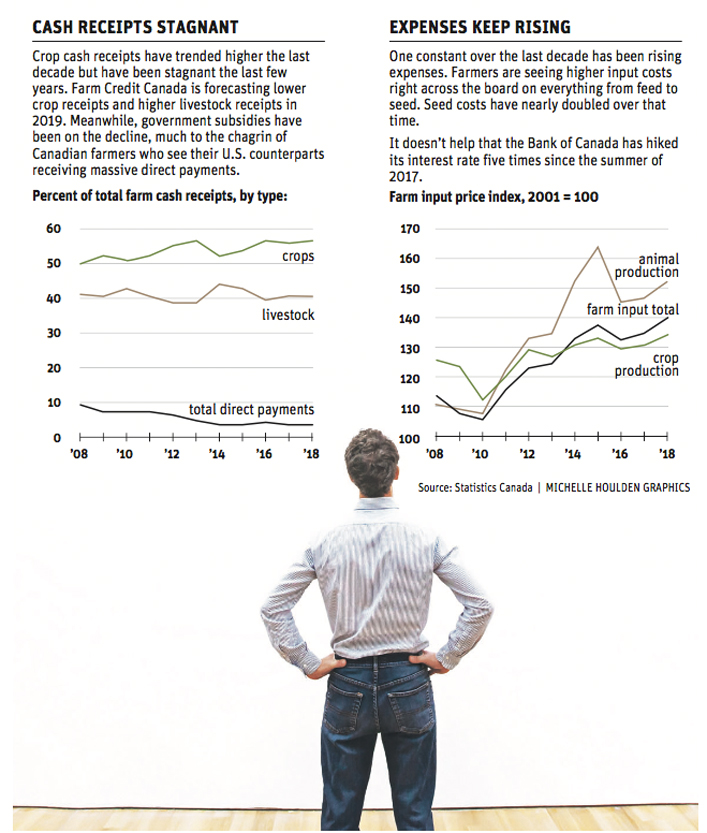High prices, weak loonie, record production and low interest rates fueled a farming boom for a decade, but the good times appear to be over
Canadian farmers are feeling the financial pinch of lost markets and rising expenses after a prolonged period of prosperity, according to recently published statistics.
Net farm income plummeted 46 percent (in constant 2012 dollars) in 2018 after seven years of above-average incomes. The outlook for 2019 is equally grim.
Farmers are reeling from the loss of key markets like China and India for canola, pulse crops, and until recently, meat products.
“The impacts of events such as these and others will be reflected in farm cash receipt and net farm income figures for 2019,” said Statistics Canada.
Read Also

Farming Smarter receives financial boost from Alberta government for potato research
Farming Smarter near Lethbridge got a boost to its research equipment, thanks to the Alberta government’s increase in funding for research associations.
Canadian farmers benefitted from high crop and livestock prices, a low Canadian dollar, record crop production, historically low interest rates and declining energy prices for much of the 2008 through 2018 period.
But the combination of trade barriers, poor growing conditions and ever-escalating costs is drastically reducing net farm income in 2018 and likely again in 2019.
J.P. Gervais, chief agricultural economist with Farm Credit Canada, said nothing has changed on FCC’s books in terms of the number of farms in arrears but there has been a noticeable tightening in key debt repayment ratios.
He forecasts a further erosion in net farm income in 2019 as rising expenses, including a series of interest rate hikes, eat into flat grain and livestock receipts. Expenses were up three percent in the first half of the year.
“If you’re in a situation like this with tight debt repayment capacity, talk to us before things get to a point where you have fewer options,” said Gervais. “It’s always ideal to get in front of these things rather than being reactive.”
It is too late to be having that conversation for hundreds of farmers south of the border.
Data from United States Courts shows 580 farm bankruptcy filings for the 12-month period ending September 2019, a 24 percent increase from the previous year.
Statistics from the Office of the Superintendent of Bankruptcy Canada show 59 agriculture, forestry and fishing and hunting bankruptcies in Canada over the same period, a 13 percent reduction from a year ago.
Keith Currie, first vice-president of the Canadian Federation of Agriculture, thinks farm equipment sales are a better barometer of the health of the farm economy than bankruptcies.
“They have remained relatively stable in the U.S. but they have certainly declined immensely here in Canada,” he said.
“That’s a prime indicator of people not spending money because they don’t have it to spend.”
Two-wheel drive tractor sales are down four percent in Canada through the first 10 months of 2019, according to the Association of Equipment Manufacturers.
Four-wheel drive tractor sales fell 35 percent, while combine sales dropped 25 percent over that same time frame.
All three categories are up between two and seven percent in the U.S. by comparison.
Gervais said the U.S. farm economy has been in a prolonged slump since 2014 due to falling commodity prices.
The financial hardship has been exacerbated by a U.S.-China trade war that erupted in 2018.
“That’s what you’re seeing in the bankruptcy numbers, not just one or two years but five consecutive years of a slowdown,” he said.
U.S. dairy farmers are hurting big time, while their Canadian counterparts have been sheltered from economic strife by supply management, said Currie.
Government subsidies are masking the carnage in the U.S. farm economy. In fact, farm income is expected to rebound to US$88 billion in 2019, the highest level since 2014, according to the American Farm Bureau Federation.
That is due to a $33 billion injection from the federal government in the form of trade assistance, disaster assistance, farm bill payments and insurance indemnities.
The bureau points out that while farm income is on the rise, so is farm debt, which is expected to reach a record $416 billion in 2019.
That is leading to the uptick in bankruptcies and loan repayment extensions.
Currie said many Canadian producers are envious of the assistance their American counterparts are receiving. Direct payments to Canadian farmers fell 8.9 percent in 2018.
“Our growers would like to see our government step up and pony up,” he said.
“But I caution growers that a cheque in the mailbox isn’t necessarily going to fix the situation.”
Currie said direct payments might be necessary to help out canola growers in the short-term but the long-term solution is reopening markets and fixing AgriStability.
In the meantime, Canadian growers will continue to struggle with stagnant receipts and rising expenses.
Total farm expenses increased 38 percent between 2008 and 2018. That comprises the following:
- A 54 percent hike in depreciation costs.
- A 45 percent rise in wages.
- A 27 percent escalation in feed costs.
- A 36 percent increase in fertilizer expenses.
- A 93 percent or near doubling in seed prices.
- An 89 percent surge in farmland rent.



















